***USE ONLY AS A LAST RESORT, SECOND TO AN ACTUAL FINDER SCOPE***
(iPhone GPS alignment is unreliable when used near the metal tube of a telescope.)
After reading a thread that someone bumped on CloudyNights related to iPad astronomy apps, someone mentioned doing something similar to what I wrote about in my last post, using an iDevice as a setting circle device. I will continue to use SkySafari as a visual reference, but as my post showed, the compass was not nearly as accurate enough as I needed it to be in order for my iPhone to be a real search tool. My next plan of attack was to find a way to use SkySafari as a finderscope utility instead.
All I needed was a way to mount my iPhone vertically on the tube of my XT8. As you might have guessed, most mounts have suction cups and a metal telescope tube is both temperature sensitive and rounded, so a suction cup will not stick, and even if it did, changes in temperature and moisture would make the thing fall off, putting my iPhone at risk of being damaged. Since I own a fairly new iPhone 4S, this was not something I wanted to risk at all.
I had an old mount I still use with my Palm TX when I go on road trips (I use my Palm as a GPS). It has a suction cup attachment, but the main mount is adjustable and it slides off of the other part. This means I can not only place my iPhone in between its grips, but that it can be attached to something else.
I fiddled with an elastic band and rubber bands to no avail. I examined my spare dovetail bracket from my old EZ Finder II red dot finder. None of that worked. However, the mounting bracket in question had feet that slid side to side, but not easily. My dovetail on the XT8’s tube had a gap underneath wide enough for these adjustable feet to securely slide underneath and up against its edges, proving to be a secure fit.
One problem solved.
The iPhone can sit in the cradle between the grips just fine. I am concerned that in the future, the iPhone might slip out from between the grips, but for now, I am not going to worry about it.
I tried SkySafari first, setting my scope at a nearby window with Spica and Saturn within view. I put on my 8×40 scope and located Spica because it was the lowest of the two in the sky and easier to find from behind a window inside a house. SkySafari was close, but it did not cooperate well. It was jumpy and more importantly, incorrect. My GPS settings were correct in SkySafari. It just didn’t want to align with what I had in the sky. It was waaay off.
Stellarium for iOS has a similar compass feature, so I launched it and hit the button. The alignment was a lot closer. As an added benefit, Stellarium also allows us to zoom in a lot closer and still use the compass feature. SkySafari does not. After sliding the mount to the side a little and tilting my iPhone down a tad (traditional X/Y alignment steps for any finder scope), Spica was centered. I moved my telescope up to Saturn using Stellarium as the guide. Sure enough, in my 32mm eyepiece, I saw Saturn.
Problem solved…for now. I’m going to give this a try in the field. Hopefully, it will be as reliable as it behaved tonight. Otherwise, it’s back to the drawing board I go. I’m not sure if you can find a mount similar to this one anymore, but I’m sure there is something out there for fellow iPhone astronomers. Improvisation is always welcome in this realm.
To summarize:
Step 1: Find a suitable mounting bracket.
Step 2: Use a functional finderscope to sight yourself into a known object.
Step 3. Install mounting bracket and make sure it is securely in place.
Step 4. Place iPhone in cradle.
Step 5. Run Stellarium and align with a known object on screen in reference to object in eyepiece. Zoom in close to verify alignment. Search for a nearby unknown object, remembering the location of the known object relative to the iPhone screen.
Step 6: Repeat Step 5 for subsequent objects. Have fun!
Example #1:
Locate Arcturus in Boötes with a finderscope.
Swap out the finderscope for the iPhone cradle.
Hit the compass feature in Stellarium.
Position iPhone in cradle so that Arcturus is visible somewhere on screen.
Make a mental note of the approximate location of Arcturus on the screen.
Do a search for M3 in Stellarium.
(Brackets will appear on the screen, denoting the location of M3.)
Resume compass mode.
Move telescope so that the brackets align to the same spot on the screen as Arcturus.
M3 should be visible in your eyepiece somewhere nearby.
Repeat for the next object, using a nearby landmark.
Example #2:
Locate Dubhe in Ursa Major.
Align iPhone with Stellarium.
Do a search for M81 or M82.
Re-enter compass mode.
Move telescope to M81 or M82.
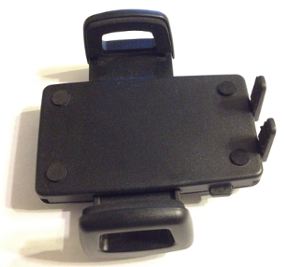
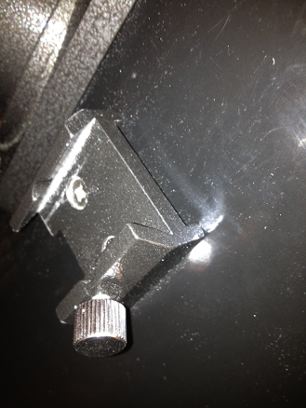
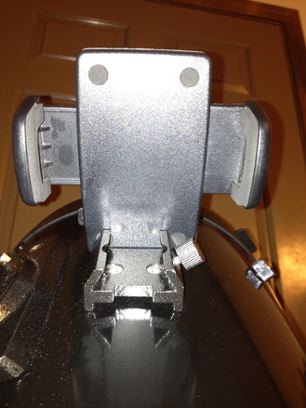
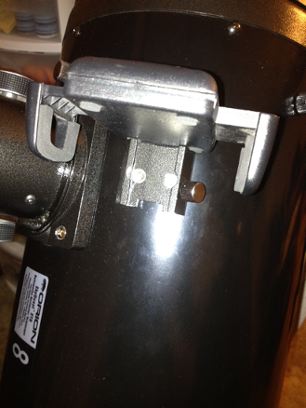
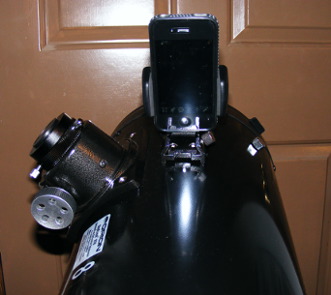
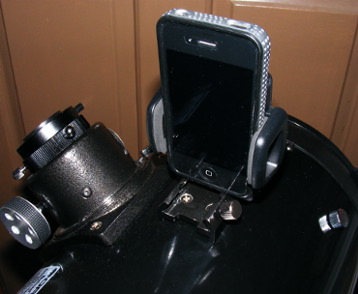
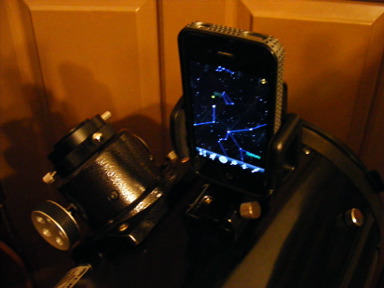
What about using a piece of grippy fabric between the phone and cradle and grips, to help keep the iphone from slipping? Don’t know what you would call it on your side of the water – over here it is marketed for elderly/disabled people who have difficulty holding trays steadily etc, – if you line a tray with this stuff, you can carry drinks at silly angles and they never move, but there is no adhesive involved, just friction, so it wouldn’t spoil your phone and might make it more secure.
I guess forgot to mention that mine came that way with a gripping fabric lining the tops of the feet. Many device cradles have it already.
I like the idea, by the way! Cunning!